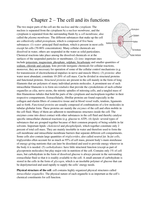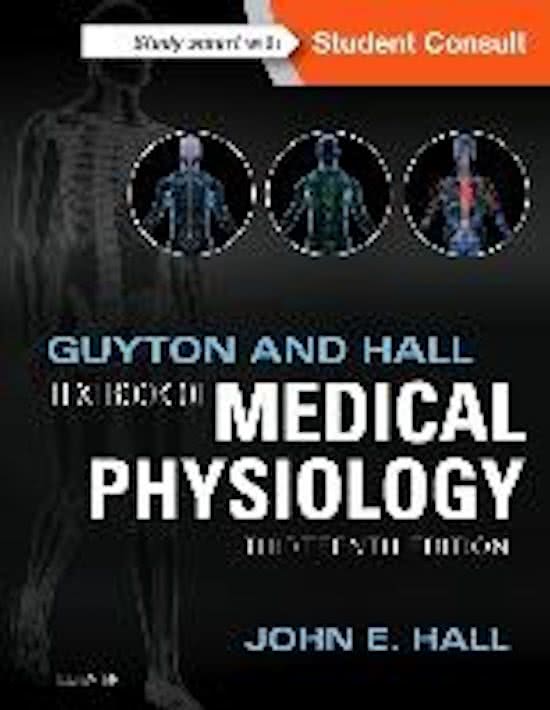Chapter 2 – The cell and its functions
The two major parts of the cell are the nucleus and the cytoplasm. The
nucleus is separated from the cytoplasm by a nuclear membrane, and the
cytoplasm is separated from the surrounding fluids by a cell membrane, also
called the plasma membrane. The different substances that make up the cell
are collectively called protoplasm, which is composed of five basic
substances: (1) water: principal fluid medium, which is present in most cells
except fat cells (70-80% concentration). Many cellular chemicals are
dissolved in water, others are suspended in the water as solid particulates.
Chemical reactions take place among the dissolved chemicals or at the
surfaces of the suspended particles or membranes. (2) ions: important ones
include potassium, magnesium, phosphate, sulphate, bicarbonate and smaller quantities of
sodium, chloride and calcium. Ions provide inorganic chemicals for cellular reactions,
moreover, they are necessary for operation of some of the cellular control mechanisms (e.g.
for transmission of electrochemical impulses in nerve and muscle fibers). (3) proteins: after
water most abundant; constitute 10-20% of cell mass. Can be divided in structural proteins
and functional proteins. Structural proteins are present in the cell mainly in the form of long
filaments that are polymers of many individual protein molecules. A prominent use of such
intracellular filaments is to form microtubules that provide the cytoskeletons of such cellular
organelles as cilia, nerve axons, the mitotic spindles of mitosing cells, and a tangled mass of
thin filamentous tubules that hold the parts of the cytoplasm and nucleoplasm together in their
respective compartments. Extracellularly, fibrillar proteins are found especially in the
collagen and elastin fibers of connective tissue and in blood vessel walls, tendons, ligaments
and so forth. Functional proteins are usually composed of combinations of a few molecules in
tubular-globular form. These proteins are mainly the enzymes of the cell and often mobile in
the cell fluid. Many of them are adherent to membranous structures inside the cell. The
enzymes come into direct contact with other substances in the cell fluid and thereby catalyse
specific intracellular chemical reactions (e.g. glucose to ATP). (4) lipids: several types of
substances that are grouped together because of their common property of being soluble in fat
solvents. Important lipids: cholesterol and phospholipids, which together constitute only 2
percent of total cell mass. They are mainly insoluble in water and therefore used to form the
cell membrane and intracellular membrane barriers that separate different cell compartments.
Some cells also contain large quantities of triglycerides, also called neutral fat. In fat cells,
triglycerides often account for as much as 95% of cell mass, present body’s main storehouse
of energy-giving nutrients that can later be dissoluted and used to provide energy wherever in
the body it is needed. (5) carbohydrates: have little structural function (except as part of
glycoprotein molecules) but play major role in nutrition of the cell. Contains only 1% of cell
mass, but carbohydrate in the form of dissolved glucose is always present in the surrounding
extracellular fluid so that it is readily available to the cell. A small amount of carbohydrate is
stored in the cells in the form of glycogen, which is an insoluble polymer of glucose that can
be depolymerized and used rapidly to supply the cells’ energy needs.
Physical structure of the cell: cell contains highly organized physical structures called
intracellular organelles. The physical nature of each organelle is as important as the cell’s
chemical constituents for cell function.






